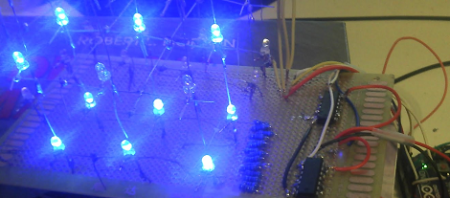[Isaac] sent in his mashup build of a LED cube combined with a graphic EQ meter. The build is fairly simple and from the video we can tell that his build would be a great installation in a dubstep venue. While it’s not the 9x9x9 cube possible with some judicious coding we think it’s a very fitting display for the intended purpose.
Unlike purely analog audio visualizations using resistor and capacitor networks, the MSGEQ7 is a 7-band graphic equalizer IC that requires basically no support circuitry. The cube is powered from a few shift registers and takes up three pins on his Arduino.
Even with freaking enormous LED cubes, the resolution is still too low to do much of anything outside a game of Snake or Pong. Volumetric displays, while offering higher potential resolution, rely on a mechanism to spin the display around at a very high speed. [Issac]’s build gets around that limitation by only needing a few LEDs every band of his EQ. It’s a very nice build that gives a purpose to all the LED cubes out there.
















may have to steal this. I built a 4x4x4 cube for a uni project a few months back and I’ve been looking to do something with it
I did this with a 5x5x5 cube and analog bandpass filters for each column. It was a pretty fun (but intensive) project. Congrats.
Have a look at: http://imblackmath.blogspot.com/ i left some code there, its not commented though so good luck :S :)
Ok, this has some cool potential… Imaging a huge DJ cube using RGB led’s to show both amplitude but energy… it would rock
I looked at the datasheet of MSGEQ7 chip you used and cannot figure out what is the output voltage it produces. As you have experience with it, can you provide me with the answer. I assume it has a range, but their datasheet is lacking.
I wonder if it would be more effective and easier to implement the string (or more like silver ropes or chains or balls on wire…whatever) & projector method for the scale a venue would need. Or for that matter, individually addressable LED ropes.
Looks great, though.
@Lukasz i coulnd’t fnd this information either, i assume in my program that its between 0 and 5v and the values that it produces seam to match this.
Video of my 3x3x3 RGB LED Cube running a custom pulse-audio plugin, playing Bohemian Rhapsody…